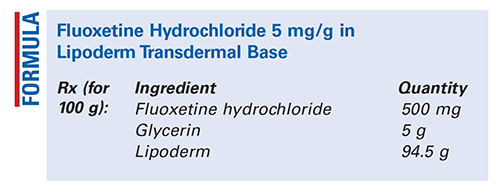US Pharm. 2022;47(5):58-59.

Method of Preparation: Calculate the required quantity of each ingredient for the total amount to be prepared. Accurately weigh or measure each ingredient. Place the fluoxetine hydrochloride (HCl) in a mortar and comminute to a fine powder. Add the glycerin and mix well to form a smooth paste. Geometrically, incorporate the paste into the Lipoderm and mix well until uniform. Package and label.
Use: Fluoxetine is a selective serotonin reuptake inhibitor (SSRI) that is used for the treatment of depression as well as other mental-health disorders.
Packaging: Package in tight, light-resistant containers.
Labeling: Keep out of reach of children. Discard after ____ [time period].
Stability: A beyond-use date of up to 30 days may be used for this preparation.1
Quality Control: Quality-control assessment can include theoretical weight compared with actual weight, pH, specific gravity, active drug assay, color, texture–surface, texture–spatula spread, appearance, feel, rheologic properties, physical observations, and preservative-effectiveness test for creams and gels.2,3
Discussion: Fluoxetine HCl (Prozac, Sarafem, C17H18F3NO.HCl, MW 345.79) occurs as a white to off-white crystalline powder that is freely soluble in alcohol and sparingly soluble in water (14 mg/mL). In addition to its use in treating depression and other mental-health disorders, this oral SSRI is also indicated for the treatment of premenstrual dysphoric disorder. Each Prozac Pulvule contains fluoxetine HCl equivalent to 10 mg, 20 mg, or 40 mg of fluoxetine, along with the following inactive ingredients: starch, gelatin, silicone, titanium dioxide, iron oxide, and others. The 10-mg and 20-mg Pulvules also contain FD&C Blue No. 1, and the 40-mg Pulvule contains FD&C Blue No. 1 and FD&C Yellow No. 6. Prozac Weekly capsules, a delayed-release formulation, contain enteric-coated pellets of fluoxetine HCl equivalent to 90 mg of fluoxetine. The capsules also contain D&C Yellow No. 10, FD&C Blue No. 2, gelatin, hypromellose, hypromellose acetate succinate, sodium lauryl sulfate, sucrose, sugar spheres, talc, titanium dioxide, triethyl citrate, and other inactive ingredients.1,4
Glycerin (glycerol, 1,2,3-propanetriol, C3H8O3, MW 92.09) occurs as a clear, colorless, odorless, viscous, hygroscopic liquid with a sweet taste about two-thirds the sweetness of sucrose. It is used as an antimicrobial preservative (>20% concentration), emollient, and humectant (up to 30% concentration); in ophthalmic formulations (0.5%-3% concentration); as a plasticizer in film coating for tablets; as a parenteral solvent (up to 50% concentration); and as a sweetening agent in alcoholic elixirs (up to 20% concentration). Glycerin has a specific gravity of about 1.25 and a melting point of 17.8°C; if cooled to crystallization, it must be heated to about 20°C in order to melt. Glycerin is miscible with water, methanol, and 95% ethanol; practically insoluble in oils and chloroform; and slightly soluble in acetone. Glycerin is hygroscopic and should be stored in airtight containers in a cool place. It is not prone to oxidation but will decompose upon heating. When glycerin is mixed with water, ethanol, or propylene glycol, the mixtures are chemically stable. Incompatibilities include strong oxidizing agents such as chromium trioxide, potassium chlorate, and potassium permanganate, which may cause it to explode. When mixed with zinc oxide or basic bismuth nitrate and exposed to light, glycerin will form a black discoloration. When it is mixed with phenols, salicylates, or tannin, an iron contaminant in the glycerin may cause the mixture to darken. Glycerin will form a strong acid complex (glyceroboric acid) when mixed with boric acid.5
Lipoderm (Professional Compounding Centers of America) is an elegant alternative to traditional pluronic lecithin organogels (PLOs) that has a smooth and creamy feel, in contrast to the tacky feel of PLOs. Lipoderm contains a proprietary liposomal component that may increase the permeation of a variety of actives. Lipoderm is a stable system that does not separate upon refrigeration, and it has great resiliency in the presence of ionic substances.6
REFERENCES
1. U.S. Pharmacopeia/National Formulary [current revision]. Rockville, MD: U.S. Pharmacopeial Convention, Inc; April 2022.
2. Allen LV Jr. Summary of quality-control testing for sterile and nonsterile compounded preparations, part 1: physical and chemical testing. IJPC. 2019;23(3):211-216.
3. Allen LV Jr. Summary of quality-control testing for sterile and nonsterile compounded preparations, part 2: microbiological testing. IJPC. 2019;23(4):299-303.
4. RxList. Prozac. www.rxlist.com/prozac-drug.htm. Accessed April 4, 2022.
5. Lou H, Alvarez-Nunez FA, Daurio D. Glycerin. In: Sheskey PJ, Hancock BC, Moss GP, Goldfarb DJ, eds. Handbook of Pharmaceutical Excipients. 9th ed. London, England: Pharmaceutical Press; 2020:453-457.
6. Lipoderm. www.pccarx.com/Products/ProductCatalog.aspx?pid=30-3338. Accessed April 5, 2022.
The content contained in this article is for informational purposes only. The content is not intended to be a substitute for professional advice. Reliance on any information provided in this article is solely at your own risk.
To comment on this article, contact rdavidson@uspharmacist.com.





